|
When I contacted Narong Wannasa for an interview, I found that he was teaching art to young students in several schools in a rural community. He said to me that he would like to give something to society without depending on a budget. For this, he refused to receive any wages when he was teaching poor students who have less money and opportunity. Those students were from Ratchaprachanukroh 27 School in Nong Khai Province, Thailand. His primary intention was for his majesty the king of Thailand.
In my view, his works are quite different from most students in art colleges and universities in various aspects. Notably, the way he applies colors and his concept of anatomy are appealing to me. As can be seen in later sets of artworks, his favorite animal he likes to draw is the buffalo.
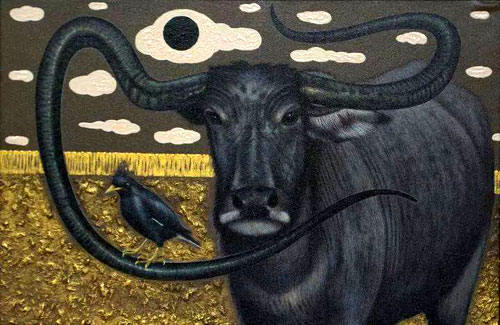 |
From a view of the past to the present, the buffalo is still a good friend of Thai farmers who grow rice. There is a little old, funny Thai proverb that mentions the relationship between a myna (bird) and a buffalo: "Myna tries to feed an old buffalo but the buffalo eats rice instead and then myna's head grows bigger." This proverb teaches children not to act lazy like a myna on the back of a buffalo and thus myna's image is seen negatively. In reality, however, the existence of the myna is very important to a buffalo as it helps to repel bugs and insects that cause harm to the animal. Those bugs and insects are a delicious food source for the birds. A flock of mynas on a buffalo is very noisy. Sometimes they tend to fight each other but this does not bother the buffalo in any way.
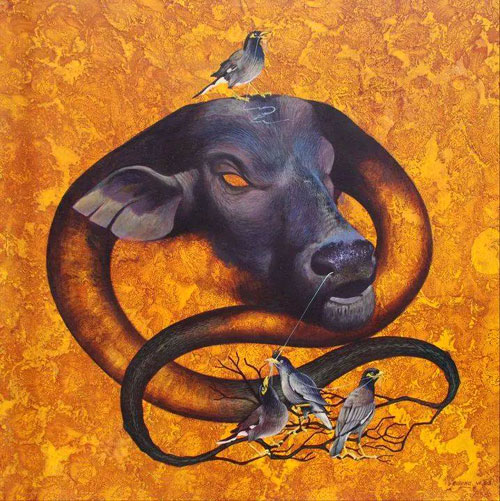 |
One day, an artist, Supawat Thonglamul, came to Chiang Mai to visit my younger brother at my house after he went to paint murals in temples in northeastern Thailand for eight months. When I met Supawat, I asked him about Narong Wannasa. I was curious about art projects that Narong returned to work on and I was not sure whether they were made by the same team or not. While Narong was waiting for his mother at the hospital, he drew eight tigers on a canvas frame and later he showed that picture on Facebook. I chatted with him briefly about this picture and he said that it was still not complete. I didn't know much about him — his personal biography, education and other previous works. At first, I asked Supawat to contact Narong to arrange an interview. Luckily, Narong said yes because at that time he was occupied with his duties as an art teacher for a school. Narong said he got a small amount of money for equipment but was willing to go to Nong Khai province.
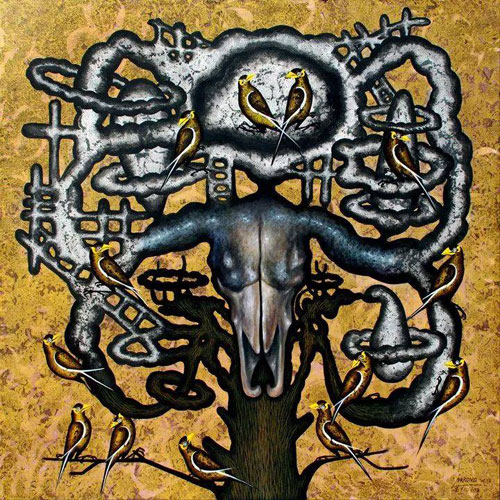 |
JY: I would like to ask you about your life as a child as well as your educational background.
NW: When I was young, my mother sent me to a boarding school for 12 years from primary school year one to high school year three. That school was called Songkroh Tawatburi and was situated in Roi Et Province. My parents have three children including me and I was the only one who was sent to the school in the other province because my mother knew that I loved drawing. To date, I have sent hundreds of my paintings to various art competitions and contests. 13 years ago I got the second prize from the United Nations Art Contest: the theme of the artwork was "Population and environment". Later I got the second prize again in a poster design competition and this time the first prize winner was African.
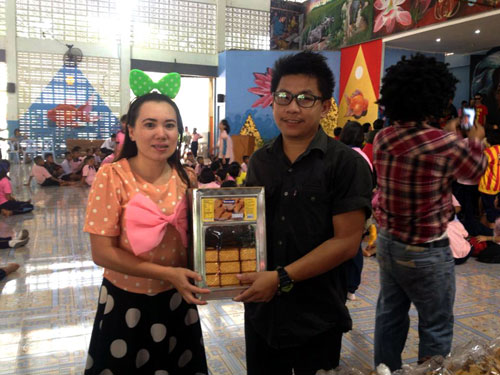 |
This was my inspiration to choose my own way of living. After I graduated from school, I decided to continue my study at Burapha University in Bang Saen, Pattaya because it was more convenient for me to find accommodation and I could manage my travel costs better. During my study there I also worked to support myself financially and my grade was not affected by this. In the third year I transferred my study credits to be an exchange student in Yunnan Province, China for one semester. The university I went to was called "The University of Da Li." The professors in the art departments were real artists and they were very compassionate. Da Li was the land of beautiful art and its scenery was spectacular. The food there was nice too. These reasons encouraged me to extend my study time and finish my bachelor's degree there. In 1991 I had my solo exhibition in Da Li and all of my paintings were almost sold out. I only took a few of them with me as a souvenir. My professors came to say goodbye to me at the airport on my last day in China and one of them gave me some final advice: he said any artist could draw a realistic portrait if he had enough training but it is better for him to find individual uniqueness.
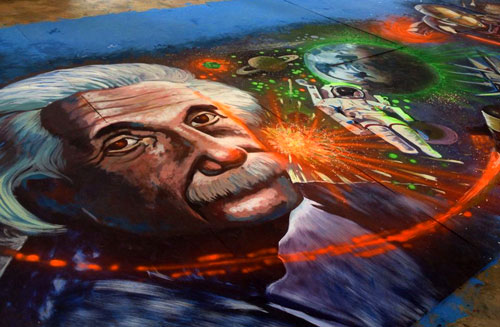 |
JY: What do you think about the image of uniqueness in Thai northeastern culture?
NW: The scenery such as mountains, forests and rice fields present unique images of Northeastern culture of Thailand. I started to think that a buffalo can be a unique representative for this. It was also the inspiration from my family in Kalasin Province. When I was a child I saw some buffaloes and farmers in the rice fields. Not only that, forests and birds are different from other regions in Thailand. I try to draw many animals such as elephants, horses, cows and buffaloes. In the end I choose to draw buffaloes in different settings and postures to convey my story and emotions. A buffalo's horn is like a branch. I used to see a flock of myna birds on a buffalo's back. There are snakes in some paintings though. The scenery of the forest in Isan region is so different from other forests. What I try my best to use in my painting are my individuality and uniqueness in the same manner as the deep soul of Thai northeastern people. Most of my present paintings are created and applied from my childhood and adulthood memories.
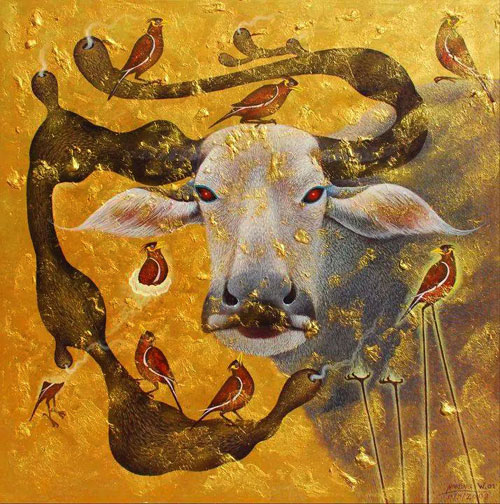 |
In my opinion, buffaloes are honest and patient animals. They are also very peaceful and adorable. Their eyes and anatomy are so sincere and friendly with people and the environment. These paintings are very popular among foreigners and can be sold at high prices. Many art collectors understand how difficult it is to make distinctive art work with patience and refinement in the way of Isan people. Besides me, there are many outstanding artists in the northeastern region of Thailand. Most of them try to include the soul of Isan people in their art works and their works are interesting. The works of Isan artists go beyond the national level but sometimes people in Thailand are not interested much. For me, I still go to paint murals in many temples, houses or schools occasionally or I am the art teacher for schools in several provinces in northeastern regions. I regard this kind of work as the devotion of my time and imagination to create a better and stable society as well as inspiring students to be good artists one day if they wish.
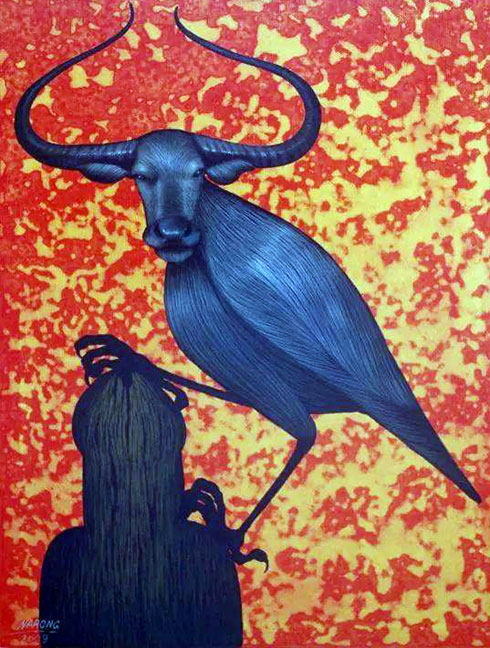 |
JY: Tell me about your past and future art exhibitions.
NW: The first one was a solo exhibition in Da Li. The second one was at the Opium Gallery in South Pattaya. This place has many foreign supporters. The third one is at Phra Nakorn Bar and the last one was a one-month exhibition at Jamjuree Gallery, Bangkok.
And so, we have good news for everyone and I am excited to announce it:
Next year, 2015, Narong Wannasa and Supawat Thonglamul, Isan Artists, will have a joint art exhibition at the American embassy in Bangkok. It is now in preparation and I hope it will be a great time for art lovers. Two Artists from Isan who work on many mural paintings for temples will come back to cooperate for the Art exhibition together. We will report on this event in a forthcoming issue..
|